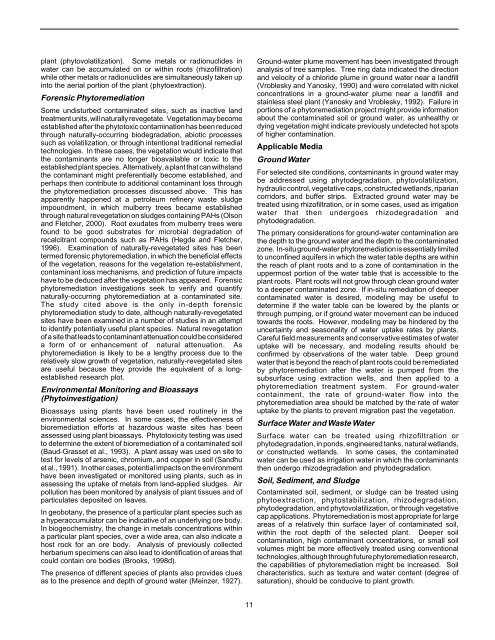Ground Water Issue - Plant Tissue Culture Research at the Univ. of ...
Ground Water Issue - Plant Tissue Culture Research at the Univ. of ...
Ground Water Issue - Plant Tissue Culture Research at the Univ. of ...
Create successful ePaper yourself
Turn your PDF publications into a flip-book with our unique Google optimized e-Paper software.
plant (phytovol<strong>at</strong>iliz<strong>at</strong>ion). Some metals or radionuclides inw<strong>at</strong>er can be accumul<strong>at</strong>ed on or within roots (rhiz<strong>of</strong>iltr<strong>at</strong>ion)while o<strong>the</strong>r metals or radionuclides are simultaneously taken upinto <strong>the</strong> aerial portion <strong>of</strong> <strong>the</strong> plant (phytoextraction).Forensic Phytoremedi<strong>at</strong>ionSome undisturbed contamin<strong>at</strong>ed sites, such as inactive landtre<strong>at</strong>ment units, will n<strong>at</strong>urally reveget<strong>at</strong>e. Veget<strong>at</strong>ion may becomeestablished after <strong>the</strong> phytotoxic contamin<strong>at</strong>ion has been reducedthrough n<strong>at</strong>urally-occurring biodegrad<strong>at</strong>ion, abiotic processessuch as vol<strong>at</strong>iliz<strong>at</strong>ion, or through intentional traditional remedialtechnologies. In <strong>the</strong>se cases, <strong>the</strong> veget<strong>at</strong>ion would indic<strong>at</strong>e th<strong>at</strong><strong>the</strong> contaminants are no longer bioavailable or toxic to <strong>the</strong>established plant species. Altern<strong>at</strong>ively, a plant th<strong>at</strong> can withstand<strong>the</strong> contaminant might preferentially become established, andperhaps <strong>the</strong>n contribute to additional contaminant loss through<strong>the</strong> phytoremedi<strong>at</strong>ion processes discussed above. This hasapparently happened <strong>at</strong> a petroleum refinery waste sludgeimpoundment, in which mulberry trees became establishedthrough n<strong>at</strong>ural reveget<strong>at</strong>ion on sludges containing PAHs (Olsonand Fletcher, 2000). Root exud<strong>at</strong>es from mulberry trees werefound to be good substr<strong>at</strong>es for microbial degrad<strong>at</strong>ion <strong>of</strong>recalcitrant compounds such as PAHs (Hegde and Fletcher,1996). Examin<strong>at</strong>ion <strong>of</strong> n<strong>at</strong>urally-reveget<strong>at</strong>ed sites has beentermed forensic phytoremedi<strong>at</strong>ion, in which <strong>the</strong> beneficial effects<strong>of</strong> <strong>the</strong> veget<strong>at</strong>ion, reasons for <strong>the</strong> veget<strong>at</strong>ion re-establishment,contaminant loss mechanisms, and prediction <strong>of</strong> future impactshave to be deduced after <strong>the</strong> veget<strong>at</strong>ion has appeared. Forensicphytoremedi<strong>at</strong>ion investig<strong>at</strong>ions seek to verify and quantifyn<strong>at</strong>urally-occurring phytoremedi<strong>at</strong>ion <strong>at</strong> a contamin<strong>at</strong>ed site.The study cited above is <strong>the</strong> only in-depth forensicphytoremedi<strong>at</strong>ion study to d<strong>at</strong>e, although n<strong>at</strong>urally-reveget<strong>at</strong>edsites have been examined in a number <strong>of</strong> studies in an <strong>at</strong>temptto identify potentially useful plant species. N<strong>at</strong>ural reveget<strong>at</strong>ion<strong>of</strong> a site th<strong>at</strong> leads to contaminant <strong>at</strong>tenu<strong>at</strong>ion could be considereda form <strong>of</strong> or enhancement <strong>of</strong> n<strong>at</strong>ural <strong>at</strong>tenu<strong>at</strong>ion. Asphytoremedi<strong>at</strong>ion is likely to be a lengthy process due to <strong>the</strong>rel<strong>at</strong>ively slow growth <strong>of</strong> veget<strong>at</strong>ion, n<strong>at</strong>urally-reveget<strong>at</strong>ed sitesare useful because <strong>the</strong>y provide <strong>the</strong> equivalent <strong>of</strong> a longestablishedresearch plot.Environmental Monitoring and Bioassays(Phytoinvestig<strong>at</strong>ion)Bioassays using plants have been used routinely in <strong>the</strong>environmental sciences. In some cases, <strong>the</strong> effectiveness <strong>of</strong>bioremedi<strong>at</strong>ion efforts <strong>at</strong> hazardous waste sites has beenassessed using plant bioassays. Phytotoxicity testing was usedto determine <strong>the</strong> extent <strong>of</strong> bioremedi<strong>at</strong>ion <strong>of</strong> a contamin<strong>at</strong>ed soil(Baud-Grasset et al., 1993). A plant assay was used on site totest for levels <strong>of</strong> arsenic, chromium, and copper in soil (Sandhuet al., 1991). In o<strong>the</strong>r cases, potential impacts on <strong>the</strong> environmenthave been investig<strong>at</strong>ed or monitored using plants, such as inassessing <strong>the</strong> uptake <strong>of</strong> metals from land-applied sludges. Airpollution has been monitored by analysis <strong>of</strong> plant tissues and <strong>of</strong>particul<strong>at</strong>es deposited on leaves.In geobotany, <strong>the</strong> presence <strong>of</strong> a particular plant species such asa hyperaccumul<strong>at</strong>or can be indic<strong>at</strong>ive <strong>of</strong> an underlying ore body.In biogeochemistry, <strong>the</strong> change in metals concentr<strong>at</strong>ions withina particular plant species, over a wide area, can also indic<strong>at</strong>e ahost rock for an ore body. Analysis <strong>of</strong> previously collectedherbarium specimens can also lead to identific<strong>at</strong>ion <strong>of</strong> areas th<strong>at</strong>could contain ore bodies (Brooks, 1998d).The presence <strong>of</strong> different species <strong>of</strong> plants also provides cluesas to <strong>the</strong> presence and depth <strong>of</strong> ground w<strong>at</strong>er (Meinzer, 1927).<strong>Ground</strong>-w<strong>at</strong>er plume movement has been investig<strong>at</strong>ed throughanalysis <strong>of</strong> tree samples. Tree ring d<strong>at</strong>a indic<strong>at</strong>ed <strong>the</strong> directionand velocity <strong>of</strong> a chloride plume in ground w<strong>at</strong>er near a landfill(Vroblesky and Yanosky, 1990) and were correl<strong>at</strong>ed with nickelconcentr<strong>at</strong>ions in a ground-w<strong>at</strong>er plume near a landfill andstainless steel plant (Yanosky and Vroblesky, 1992). Failure inportions <strong>of</strong> a phytoremedi<strong>at</strong>ion project might provide inform<strong>at</strong>ionabout <strong>the</strong> contamin<strong>at</strong>ed soil or ground w<strong>at</strong>er, as unhealthy ordying veget<strong>at</strong>ion might indic<strong>at</strong>e previously undetected hot spots<strong>of</strong> higher contamin<strong>at</strong>ion.Applicable Media<strong>Ground</strong> <strong>W<strong>at</strong>er</strong>For selected site conditions, contaminants in ground w<strong>at</strong>er maybe addressed using phytodegrad<strong>at</strong>ion, phytovol<strong>at</strong>iliz<strong>at</strong>ion,hydraulic control, veget<strong>at</strong>ive caps, constructed wetlands, ripariancorridors, and buffer strips. Extracted ground w<strong>at</strong>er may betre<strong>at</strong>ed using rhiz<strong>of</strong>iltr<strong>at</strong>ion, or in some cases, used as irrig<strong>at</strong>ionw<strong>at</strong>er th<strong>at</strong> <strong>the</strong>n undergoes rhizodegrad<strong>at</strong>ion andphytodegrad<strong>at</strong>ion.The primary consider<strong>at</strong>ions for ground-w<strong>at</strong>er contamin<strong>at</strong>ion are<strong>the</strong> depth to <strong>the</strong> ground w<strong>at</strong>er and <strong>the</strong> depth to <strong>the</strong> contamin<strong>at</strong>edzone. In-situ ground-w<strong>at</strong>er phytoremedi<strong>at</strong>ion is essentially limitedto unconfined aquifers in which <strong>the</strong> w<strong>at</strong>er table depths are within<strong>the</strong> reach <strong>of</strong> plant roots and to a zone <strong>of</strong> contamin<strong>at</strong>ion in <strong>the</strong>uppermost portion <strong>of</strong> <strong>the</strong> w<strong>at</strong>er table th<strong>at</strong> is accessible to <strong>the</strong>plant roots. <strong>Plant</strong> roots will not grow through clean ground w<strong>at</strong>erto a deeper contamin<strong>at</strong>ed zone. If in-situ remedi<strong>at</strong>ion <strong>of</strong> deepercontamin<strong>at</strong>ed w<strong>at</strong>er is desired, modeling may be useful todetermine if <strong>the</strong> w<strong>at</strong>er table can be lowered by <strong>the</strong> plants orthrough pumping, or if ground w<strong>at</strong>er movement can be inducedtowards <strong>the</strong> roots. However, modeling may be hindered by <strong>the</strong>uncertainty and seasonality <strong>of</strong> w<strong>at</strong>er uptake r<strong>at</strong>es by plants.Careful field measurements and conserv<strong>at</strong>ive estim<strong>at</strong>es <strong>of</strong> w<strong>at</strong>eruptake will be necessary, and modeling results should beconfirmed by observ<strong>at</strong>ions <strong>of</strong> <strong>the</strong> w<strong>at</strong>er table. Deep groundw<strong>at</strong>er th<strong>at</strong> is beyond <strong>the</strong> reach <strong>of</strong> plant roots could be remedi<strong>at</strong>edby phytoremedi<strong>at</strong>ion after <strong>the</strong> w<strong>at</strong>er is pumped from <strong>the</strong>subsurface using extraction wells, and <strong>the</strong>n applied to aphytoremedi<strong>at</strong>ion tre<strong>at</strong>ment system. For ground-w<strong>at</strong>ercontainment, <strong>the</strong> r<strong>at</strong>e <strong>of</strong> ground-w<strong>at</strong>er flow into <strong>the</strong>phytoremedi<strong>at</strong>ion area should be m<strong>at</strong>ched by <strong>the</strong> r<strong>at</strong>e <strong>of</strong> w<strong>at</strong>eruptake by <strong>the</strong> plants to prevent migr<strong>at</strong>ion past <strong>the</strong> veget<strong>at</strong>ion.Surface <strong>W<strong>at</strong>er</strong> and Waste <strong>W<strong>at</strong>er</strong>Surface w<strong>at</strong>er can be tre<strong>at</strong>ed using rhiz<strong>of</strong>iltr<strong>at</strong>ion orphytodegrad<strong>at</strong>ion, in ponds, engineered tanks, n<strong>at</strong>ural wetlands,or constructed wetlands. In some cases, <strong>the</strong> contamin<strong>at</strong>edw<strong>at</strong>er can be used as irrig<strong>at</strong>ion w<strong>at</strong>er in which <strong>the</strong> contaminants<strong>the</strong>n undergo rhizodegrad<strong>at</strong>ion and phytodegrad<strong>at</strong>ion.Soil, Sediment, and SludgeContamin<strong>at</strong>ed soil, sediment, or sludge can be tre<strong>at</strong>ed usingphytoextraction, phytostabiliz<strong>at</strong>ion, rhizodegrad<strong>at</strong>ion,phytodegrad<strong>at</strong>ion, and phytovol<strong>at</strong>iliz<strong>at</strong>ion, or through veget<strong>at</strong>ivecap applic<strong>at</strong>ions. Phytoremedi<strong>at</strong>ion is most appropri<strong>at</strong>e for largeareas <strong>of</strong> a rel<strong>at</strong>ively thin surface layer <strong>of</strong> contamin<strong>at</strong>ed soil,within <strong>the</strong> root depth <strong>of</strong> <strong>the</strong> selected plant. Deeper soilcontamin<strong>at</strong>ion, high contaminant concentr<strong>at</strong>ions, or small soilvolumes might be more effectively tre<strong>at</strong>ed using conventionaltechnologies, although through future phytoremedi<strong>at</strong>ion research,<strong>the</strong> capabilities <strong>of</strong> phytoremedi<strong>at</strong>ion might be increased. Soilcharacteristics, such as texture and w<strong>at</strong>er content (degree <strong>of</strong>s<strong>at</strong>ur<strong>at</strong>ion), should be conducive to plant growth.11
















